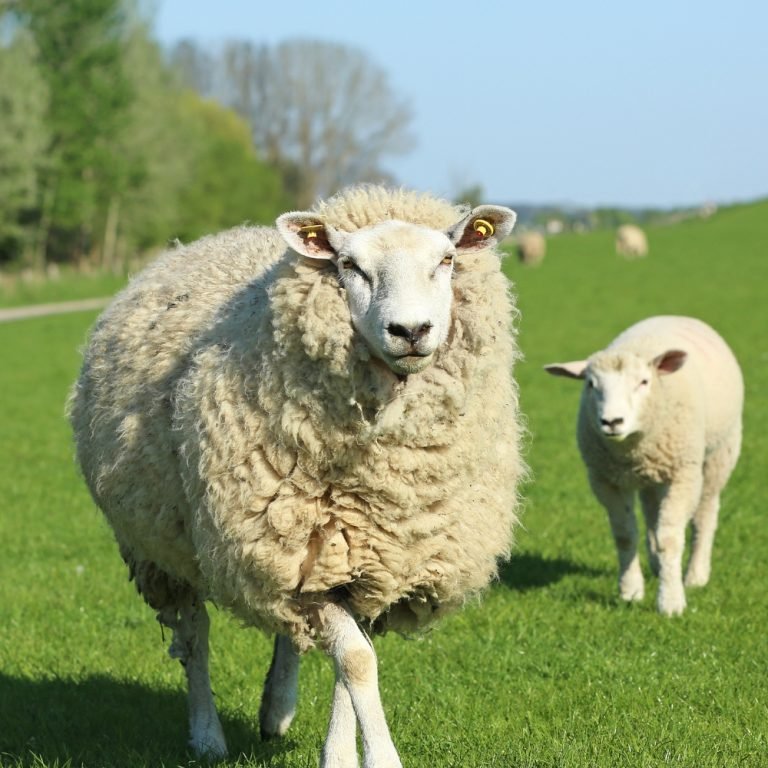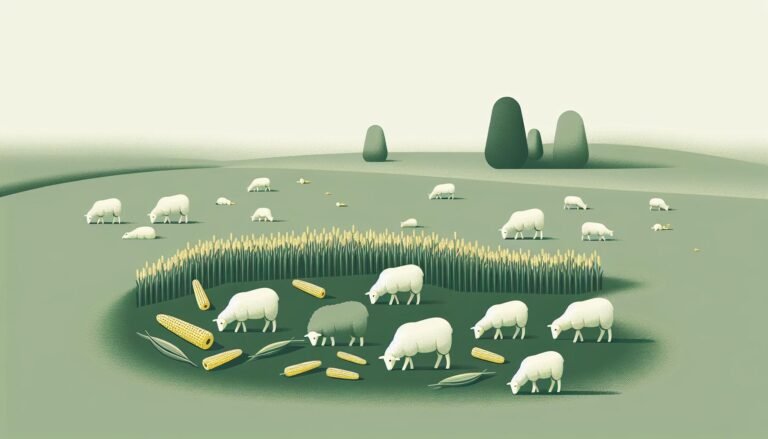Understanding Sheep Adaptation: Do Sheep Get Cold and How to Keep Them Warm?
Ever wondered, “Do sheep get cold?” It’s a question that’s crossed many minds, especially when we see them grazing in frosty fields. As a shepherd, I’ve spent years observing and understanding these woolly wonders.
Sheep, known for their thick, woolly coats, seem well-equipped for harsh weather conditions. But is that really the case? Do they feel the chill like we do, or does their woolly armor keep them snug and warm?
Key Takeaways
- Sheep’s woolly coats are designed to protect them from varying weather conditions, with crimped fibers that create tiny pockets of air for insulation.
- Despite common belief, sheep don’t overheat in their wool during warmer seasons. They regulate their body temperature through sweat glands and the ability of their coat to absorb and release moisture.
- The insulating properties of sheep’s wool include its natural crimp, high thermal resistance, and its capacity for moisture absorption and release.
- Sheep’s capacity to adapt to different climates stems from the versatility of their wool, which provides insulation from body heat loss and prevents overheating in warmer conditions.
- Factors such as age, health, physique, and quality of wool affect a sheep’s resistance to cold. For instance, newborn and older sheep are more vulnerable to cold due to lack of thick wool and potential health conditions.
- Shelter and care play crucial roles in maintaining sheep’s warmth during colder months. This includes providing adequately-constructed, weatherproof housing, performing regular health check-ups, provisioning nutritional supplements, and making provision for thermal beds.
The Anatomy of Sheep Coats
When considering if sheep get cold, it’s vital to first understand the anatomy of their coats. Sheep don’t just hav coats. There’s an impressive science to how their wool grows and functions. Sheep coats, also known as fleeces, are unique structures that provide warmth and weather protection, playing a significant role in their survival.
The wool fibers of sheep coats are crimped. This creates countless tiny pockets of air, effectively insulating the sheep. Because of this, sheep are comfortable and warm during the cold months. In fact, the more crimps or waves in the wool, the higher its quality!
But what about summer? It’s a widespread belief that sheep can overheat in their wool during warmer seasons. Contrary to these beliefs, their woolly coats also help regulate their body temperature when it gets hot outside. With special sweat glands on their skin, they cool down their bodies and reduce the risk of overheating.
To shed more light on how this works, examine the process of shearing. Farmers shear, or cut off, their fleeces annually. This not only provides us with essential wool products but also gives the sheep a more comfortable, lightweight coat for the summer. However, this does not make sheep more susceptible to the cold. Even after shearing, a layer of wool remains on their bodies, protecting them from temperature fluctuations.
Here’s a quick look at the amazing features sheep fleeces offer.
Feature
|
Benefit
|
Crimped Fibers
|
Provide insulation and warmth
Sweat Glands
|
Regulate body temperature and prevent overheating
Layer of Wool
|
Protects sheep even after shearing
It’s clear to see how these unique features play an essential role in the question of whether sheep get cold. So next time you see a sheep, you’ll know the remarkable details that help them adapt to different weather conditions, thanks to their apparent wooly armor.
Understanding the Insulating Properties of Wool
Wool has some prime properties that make it an exceptional insulator. Part of the effectiveness can be traced to wool’s natural crimp. This crimp weaves its way through the material, forming countless tiny pockets of air. Air, as it turns out, is pretty good at insulating. It’s actually considered one of the best insulators because it can reduce heat transfer dramatically.
To visualize the effect, consider a winter coat packed with down feathers. It’s not the feathers themselves providing the warmth you’re feeling, but the pockets of air trapped within the clustered feathers. The same principle applies to wool. It’s these air pockets, formed by the crimp of the wool fibers, that provide the core of wool’s insulating property.
In addition to these micro air pockets, wool also has a high thermal resistance. This means it’s harder for heat to pass through wool than other materials. For sheep, this is a lifesaver during the cold winter nights. It slows down the transfer of their body heat to the freezing environment, keeping them warm and healthy.
Another intriguing feature of wool is its ability to absorb and release moisture. When the environment is damp, wool can absorb up to 30% of its weight in moisture. As the air dries up, this moisture is released back into the environment. This cycle of moisture absorption and release helps the sheep maintain a comfortable body temperature regardless of fluctuations in weather conditions.
To tally the content above, I crafted a table that encapsulates the essential properties of wool that lend to its insulation.
| Property of Wool | Insulating Advantage |
|---|---|
| Natural Crimp | Creates tiny air pockets which impede heat transfer |
| High Thermal Resistance | Prevents heat loss from body |
| Moisture Absorption & Release | Helps regulate body temperature |
These natural aspects highlight why wool is truly an extraordinary insulator. The idiosyncrasies of how and why wool works the way it does, still baffle scientists, but what’s undeniably clear is that it performs its job superbly.
How Sheep Adapt to Different Climate Conditions
A common misconception is that sheep would shiver in the cold just like us humans would. But here’s an interesting fact: sheep have evolved to brace even the most challenging weather conditions, and all thanks to their exceptional coat of wool.
Wool, as we’ve learned, does much more than just keep sheep toasty during the colder months. It’s a versatile material with unique properties that allow sheep to thrive in a variety of climates. To understand just how beneficial wool is, let’s dig a little deeper.
The secret lies in the crimp of the wool. It’s the natural crimping or curling that forms millions of tiny air pockets. These air pockets function as an insulating barrier. Not only do they prevent loss of body heat, but they also help keep heat out when temperatures soar. Essentially, wool is an all-weather garment for sheep.
On top of that, wool’s got a high thermal resistance. This means it’s incredibly hard for heat to pass through it. So, in a snowy subzero field, sheep stay warm. But, on an arid dry grassland, they avoid overheating. Competing with this insulating efficiency is tough.
| Property | Description |
|---|---|
| Crimp | The thing that forms air pockets for insulation |
| Thermal Resistance | The property that keeps heat from passing through |
But wait, there’s more! Wool can also absorb and release moisture, thereby helping to regulate body temperature. When it’s damp, wool can still retain warmth, unlike cotton or linen. Rain or shine, snow or sleet, sheep confidently roam around in their perfect self-provided outfit, almost indifferent to the diversity of climate.
So, the question “Do sheep get cold?” hardly arises. It’s their remarkably adapted wool that enables these humble animals to endure an array of weather conditions with relative ease. The fluffy wool has finely tuned these fleecy ruminants to nature’s broad strokes of sunshine, rainfall, snowfall, and everything in between.
While it’s true that sheep, like any living creature, have limits to the extremes of cold and heat they can endure, their wool plays a substantial role in affording them a broad survival range. It’s why sheep are found in different parts of the world – whether it’s the chilly heights of New Zealand’s mountains or the hot confines of Africa’s savannahs.
Factors That Affect Sheep’s Sensitivity to Cold
Now let’s dig deeper into the factors that influence a sheep’s sensitivity to cold. Age, health, physique, and the quality of its wool are key variables that considerably impact a sheep’s ability to withstand the harsh chill of winter.
Age plays an integral role in any living being’s resistance to cold. Just as human infants and elderly are more susceptible to freezing temperatures, young and old sheep are also significantly more vulnerable. Newborn lambs lack the thick wool that help adult sheep stay warm, and older sheep may have health conditions that make it harder for them to endure cold weather.
Health is another critical factor. A strong, well-fed sheep with no underlying health issues is likely to handle winter conditions far better than a weak, undernourished one. An animal’s general health condition significantly influences its ability to regulate body temperature and, thus, face cold weather conditions.
Physique can’t be ignored. Sheep that are naturally large and have more body fat may be more equipped to handle freezing temperatures than their thinner counterparts. Body fat acts as insulation, helping to trap warmth within.
Lastly, the type and quality of a sheep’s wool greatly affects its resistance to cold. As we’ve already discussed in the previous sections, wool is a superb insulator due to its unique crimped structure that forms tiny air pockets. These hold warm air, aiding sheep to maintain their body temperature even in biting weather conditions.
However, not all wool is created equal. Some sheep breeds have wool more effective for cold resistance due to its better insulative properties, greater thickness, and more extensive coverage.
Just as different car makes and models are manufactured for diverse climate and terrain conditions, the adaptability of sheep to cold also varies. Understanding these variations can help us devise better strategies for taking care of sheep during winter. It also further underscores the incredibly adaptive nature of sheep – a testament to their resilience and survival skills.
The Role of Shelter and Care in Keeping Sheep Warm
While wool is great at helping sheep to regulate their body temperature, access to adequate shelter is also instrumental in their winter survival. Sheep need protection from rain, chilling winds and heavy snowfall during particularly cold months. By offering a well-constructed and weatherproof shelter, we can help sheep to stay warm and dry. Whether it’s a custom-built barn or a simple lean-to structure, the key is to provide a space that deflects harsh weather conditions and prevents drafts from chilling the herd.
That said, it’s also important to consider the inside environment of the shelter. Poor ventilation can create a damp environment, which reduces the insulating effectiveness of wool, increasing sheep’s vulnerability to cold.
Continued management of the herd also plays a pivotal role in keeping them warm. Routine checks on the sheep’s physical condition, observing behavior changes, and providing nutritional supplements will greatly boost their resistance against cold weather.
Particular attention should be paid to newborn lambs and older sheep. These groups are more susceptible to cold, requiring extra warmth and care. Additional attention to these vulnerable groups will help to ensure their survival during cold periods.
Let’s not forget that during winter, sheep require more energy to increase their metabolism and generate body heat. Hence they need to be supplied with food rich in energy like concentrates and high-quality hay. This extra nutrition will help sheep to cope with the drop in temperatures over the winter months.
Placing thermal beds in shelters also aids in creating a warm, dry place for sheep to rest, ensuring they’re less likely to suffer from cold-related issues.
By understanding how shelter and care can contribute to sheep’s warmth, we can do our part in protecting these animals during colder months.
The next section of the article will further delve into sheep’s resilience to cold and it’ll look into each breed’s unique adaptability. This will help us to understand why some sheep breeds tend to be more cold resistant than others.
Conclusion
Sheep have a unique ability to adapt to cold weather, thanks to their wool’s insulating properties. Yet, it’s not just about the wool. Age, health, physique, and wool quality all play a part in a sheep’s cold resistance. Newborn lambs and older sheep need extra care, and a sheep’s overall health and physique can make a difference in its ability to handle the cold. Adequate shelter and nutritional support are key to keeping sheep warm in winter. By providing shelters that shield sheep from harsh weather conditions and offering them energy-rich food, we can help these animals thrive in colder climates. It’s also beneficial to place thermal beds in shelters, giving sheep a warm place to rest. Remember, understanding sheep’s adaptability to cold weather is vital for their care and protection during winter.







